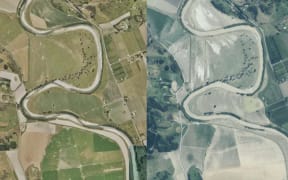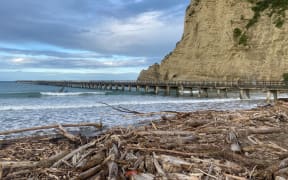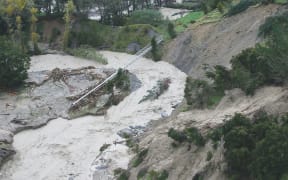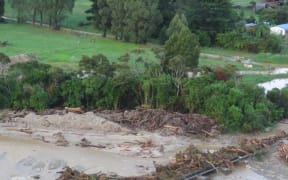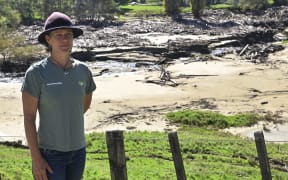
Flood debris at Fernhill bridge and Ngaruroro Road in Hawke's Bay after Cyclone Gabrielle. Photo: Jonathan Bixley
Pine made up the majority of wood debris left behind after Cyclone Gabrielle in Hawke's Bay, but very little of it was "slash", a council survey has found.
Hawke's Bay Regional Council on Wednesday released its report into the make-up of wood debris, which damaged bridges and were left littered on flooded areas and beaches after Cyclone Gabrielle.
The survey of 15 sites found a mixture of pine, willow, poplar, native timber, and other debris that could not be identified.
The mix of material differed from each catchment, with the majority of pine coming from the erosion of hillsides and stream banks.
The council said it was particularly interested to learn the degree to which the pine debris included harvested logs, "slash" (branches and leftover debris from harvesting, pruning or thinning), or were whole or parts of trees from eroded hillsides and stream banks.
The report said there was little evidence of "slash" - leftover material from harvesting and pruning - in any site except one.
On average, pine made up 56 percent of the wood debris in the sites, with some combination of willow and poplar or other species making up 21 percent on average.
Pine made up the majority of material in nine sites, and was 90 percent of it in three places.
In one area, it was just five percent of the debris.
On average, the most common wood debris recorded was 'pine piece' - defined as bits that did not have cut marks which indicate being harvested.
"It is not unreasonable therefore to assume that this type of debris may have originated from trees damaged by cyclonic winds with pieces ... subsequently entering waterways," the report said.
It said there was no longer any question wood debris were a significant environmental and social issue for Hawke's Bay and the East Coast.
The report described the cyclone as a "catastrophic weatherbomb" and one of the most significant weather events in the region on record, with a number of places getting half a metre of rain.
Eighteen bridges were damaged in the region because of it.
More detail from the survey
Wood debris at Esk River and beach, Aropaonui, Waikare, Mohaka and Mahia beaches, and Wairoa rivermouth were all predominantly pine - with some other types mixed in.
Upper Tutaekuri and Mangaone, Dartmoor and Rissington were also mostly pine with some willow.
Te Ngarue was a mix of pine and willow.
Lower Tutaekuri, Puketapu, and Awatoto were predominantly willow and popular with the remaining pine.
The report said pine plantations and wilding pine were found extensively across Hawke's Bay.
It said much of the pine had previously been knocked down by wind, was left after being cleared by the community, or was unable to be traced.
"Areas of riverbank willow plantings have remained in place despite the flood event, proving they remain one of the best options for erosion control."
Willow is an effective species to plant to prevent erosion and for riparian planting, the report noted.
It said the tree species' proximity to rivers, and the strength of the floodwaters, contributed to the willow being found in the sites tested.

